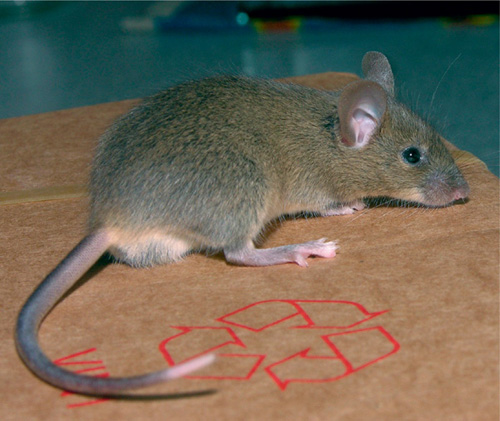
Mus musculus
House Mouse is a true mouse. It inhabits human settlements and can live and multiply in enclosed spaces, even under extreme conditions, for example, in cold-storage rooms with temperatures below freezing. It can survive for long periods without water.
House Mouse has two morphs—dark and light. The light morph is light grey to greyish brown on its back and light grey to white on its belly, and is common in eastern Europe. The dark morph is dark grey to greyish black on the back, and is especially widespread in western Europe.
In summer, the light morph is found near buildings and in gardens and parks, hedgerows, bushes, open woodland, and areas with tall grass, only rarely in cultivated fields since these have insufficient insects, green plants, or weed seeds. In autumn the light morph moves inside. Dark-morph House Mice live mostly indoors year-round.
The House Mouse has a distinctive smell. Biopix.

The eyes, ears, and tail are smaller than those of Wood Mouse. House Mouse is 7.5–10 cm long, and the tail is 7–10 cm. It weighs 12–28 g. The tail is uniformly coloured, the same length as the body or a little shorter.

House Mouse prefers cereals and plant seeds but also eats plants and insects. Indoor mice will eat almost anything, for example, soap and candles. They will also create numerous food caches. Feeding areas are often dirtied with urine and scat.
House Mouse has four toes on the forefoot and five on the hind. The front print is about 1 cm long and 1.3 cm wide, the hind print up to 1.8 cm long and 1.8 cm wide. On soft terrain, in sand, dust, or sawdust, you can clearly see the tracks of the tail. House Mice follow clearly marked paths both inside and outside, and they travel them by walking rather than hopping or jumping, unlike Yellow-necked Mouse and Wood Mouse. The tracks are half the size of those of rats.
Mice leave pungent-smelling scat and urine everywhere, scent-marking their presence for other mice. This is why food can attract bacteria; for example, Salmonella can be transmitted to humans and other animals in this way. The scat of Yellow-necked and Wood Mice does not smell.
House Mouse scat is about 6 mm long and 2–2.5 mm thick; rat scat can be up to 17 mm long and 4.6 mm thick.
House Mice are good climbers and swimmers; young mice can squeeze through cracks no wider than 7–8 mm, adult mice through gaps about 1 cm wide. They can chew through a great diversity of materials with their sharp teeth, and they leave holes in cupboards, floorboards, and insulation. Mouse holes are about 2 cm in diameter, rat holes about 5–7 cm. The gnaw marks left by the front teeth of a House Mouse are less than 2 mm wide, those left by rats, about 3 mm.
Mouse tracks in snow. PN.

Where building materials are soft, House Mice can create tunnel systems 2–3 cm in diameter where they make nests and store food. Conical nests of dried grass, about 10 cm in diameter, are built outdoors; indoor nests are constructed with all kinds of materials, including paper, pieces of fabric, insulation, straw, feathers, and wood shavings.
A House Mouse is sexually mature after two months, and a litter often comprises 10–12 young.


House Mice eat grain kernels from the side, holding them with their front feet. You can see tooth marks on gnawed kernels. Rats start gnawing a kernel from the end.
Beware! Mice and rats can transmit Salmonella to humans. If you touch mice or rats when removing them from traps, or touch old, used traps without wearing gloves, you must wash your hands thoroughly afterwards. A salmonella infection can be very unpleasant, even deadly.
Mice can cause considerable damage by chewing fabric. LS.
